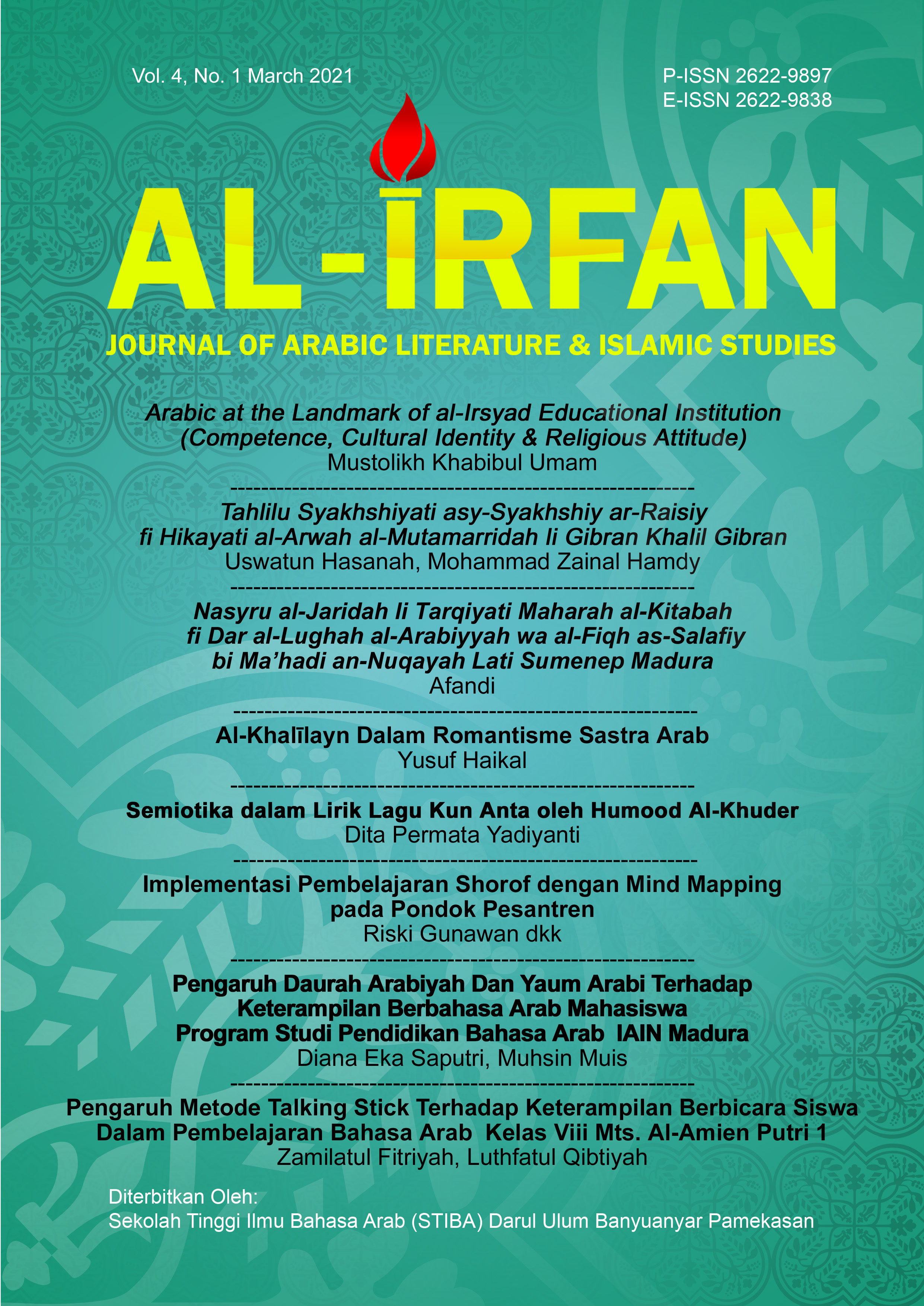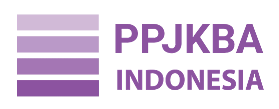Arabic at the Landmark of al-Irsyad Educational Institution (Competence, Cultural Identity & Religious Attitude)
DOI:
https://doi.org/10.36835/al-irfan.v4i1.4280Keywords:
Bahasa Arab, Kompetensi, Identitas sosial, Sikap keberagamaanAbstract
The paper focused on the educational institution of al-Irsyad Tengaran which emphasizes the learning process in Arabic. It is among Arabic competence, social identity and religious attitudes become the reason why Pesantren educational institutions are still existing and developing in some parts of Indonesia. As Islamic pesantren they also prioritize teachings based on purification of Islam free from heresy, superstition and khurafat. This research is a qualitative research method, that can be expected to produce descriptive data in the form of written or spoken words from a number of people and observable behavior. While the approach used is a communicative approach that is an approach with the aim of making communicative competencies as the goal of language learning. In the process of data analysis, there are three main components that must be understood and understood by each researcher. The three components are data reduction, data presentation, and inference or verification. The first step is to standardize arabic competencies that are needed as an evaluation material for their teachers to see how far the students have mastered the Arabic language material that has been taught. it will continue with the development of their way of thinking in the community through the implementation of da'wah training spread in the community as a place to prove their identity as santri al-Irsyad who uphold their educational institutions. The cultural identity that is built will shape their religious attitudes in the society since has been the beginning of Islam echo that is free from religious rituals containing heresy, superstition and khurafat. From these components will form a reason why Arabic is particularly important in the progress and development of educational institutions that have the slogan of restoring the glory of Islam through Arabic.References
Arsyad, Azhar. In Bahasa Arab dan metode pengajarannya, 14. Yogyakarta: Pustaka Pelajar, 2003.
Azra, Azyumari. In Esei-Esei Intelektual Muslim dan Pendidikan Islam, 140. Jakarta: Logos Wacana Ilmu, Cetakan ke-1, 1998.
Dihyatun. Nahwa Istrartijiyaj Ta'limul Lughoh Al Arabiyah Al Fa'aliyah. Performed by Makalah Kuliah Tamu. UIN Malang. Maret 16 , 2003.
Dorais, Louis Jacques. "Into it Identity in Canada" in Folk. Vol. 30, 1988: 23-31.
Furchan, Arief. "Transformasi Pendidikan Islam di Indonesia." 5. Yogyakarta: Gama Media, 2004.
Hitti, Philip K. In History of Arabs, 708. Jakarta: PT Serambi Ilmu Semesta, 2005.
https://www.pesantrenalirsyad.org/profil-pesantren-islam-al-irsyad-tengaran/, diakses 3 Oktober 2019. n.d.
John, Benjamins. In Explorations in the Sociology of Language and Religion, 78. Amsterdam : Publishing Company, 2012.
Kahmad, Dadang. In Sosiologi Agama, 97. Bandung: PT. Remaja Rosdakarya, 2009.
Khalwani, Ahmad. Pentingnya Kemampuan Bahasa Arab untuk Belajar Agama. n.d. (accessed Oktober 4, 2019).
Kushartanti. In Pesona Bahasa; Langkah Awal Memahami Linguistik, 127. Jakarta: PT Gramedia Pustaka Utama, Cetakan ke-1, 2005.
Lubis, Akhyar Yusuf. In Teori dan Metodologi “Ilmu Pengetahuan Sosial Budaya Kontemporer, 110. Jakarta: Raja Grafindo Persada, 2014.
Moleong, Lexy J. In Metodologi Penelitian Kualitatif , 6. Bandung: PT. Remaja Rosdakarya, 2010.
Mu’in, Abdul. In Analisis Kontrastif Bahasa Arab & Bahasa Indonesia “Telaah terhadap Fonetik dan Morfologi , 51. Jakarta: Pustaka al-Husna Baru, 2004.
Murtadlo, Nurul. Metode Pengajaran Bahasa Arab Bagi Masyarakat Indonesia. Performed by Makalah Seminar. UIN , Malang. 2003.
Oniel, Salami. In Arabic and Sociocultural Change among the Yoruba, 45. New York: Palgrave Macmillan, 2010.
Rummens. In Personal Identity and Social Structure in Saint Maartin: A Plural Identity Approach, 157-159. New York University: UnpublishedThesis/Dissertation, 1993.
Soehadha, Moh. In Metode Penelitian Sosial Kualitatif Untuk Studi Agama, 129. Yogyakarta: SUKA-Press UIN Sunan Kalijaga, 2012.
Tarigan, Henry Guntur. In Pengajaran Kompetensi Bahasa, 22. Bandung: Angkasa, 1990.
Thoimah, Rusdi. In Ta’limul Lughoh Lighoiri Nathiqina Biha, Manahijuhu Wa Asalibuhu, 16. ISESCO, 1989.
Wahid, Abdurrahman. In Islam Kosmopolitan; Nilai-nilai Indonesia & Transformasi Kebudayaan, 134. Jakarta: The Wahid Institut, Cetakan ke-1,, 2007.
Wellington, Downes. In Language and Religion: A Journey into the Human Mind , 32. New York: Cambridge University Press, 2011.
Downloads
Published
How to Cite
Issue
Section
License
Copyright (c) 2021 Mustolikh Khabibul Umam

This work is licensed under a Creative Commons Attribution 4.0 International License.
Lisensi :
Al-Irfan: Journal of Arabic Literature and Islamic Studies is published under conditions Creative Commons Attribution 4.0 International License / CC BY 4.0 This license permits anyone to copy and redistribute this material in any form or format, modify, modify, and make derivative works of this material for any purpose, including commercial purposes, so long as they credit the author for the original work.











